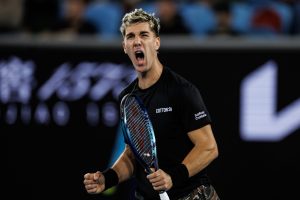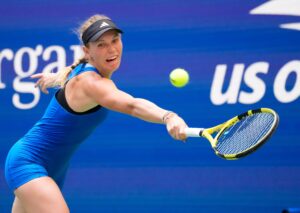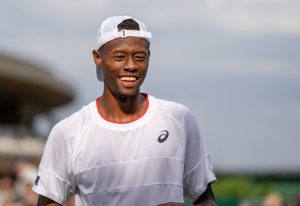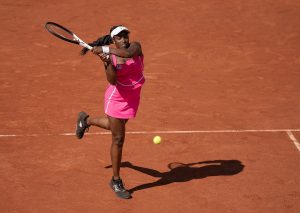Two years ago on a blustery gray day, typical of northern Illinois in November, a long haired Southern Californian announced his arrival on the Challenger tour with a hard fought win over tour veteran Austin Krajicek in the quarterfinals of the Champaign-Urbana Challenger. The 22-year-old Clay Thompson used an aggressive attacking style to show a larger audience what so many in the NCAAs and Southern California already knew–that he was full of talent and style on the court. What many who were at that tournament, or who turned in to the streams, found refreshing was Thompson’s openness on the court– his freeness to let his personality show in all its prism’d dimensions. A tennis audience that often is only privy to the negative emotions released through racquet smashes and ball boy abuse, saw the full gambit of emotions from Thompson, as he laughed through pressure, narrated his mistakes, and applauded his opponent’s shot making. An audience left the match not only impressed by superior tennis skill, but entertained–something crucial to the development and popularity of any sport, and something that has often been deemed missing from today’s tennis game.
Thompson’s Story In Reverse
With his Champaign coming out, Thompson grew his cult-like following. What started with Thompson being a regional favorite on the college and future’s scene in Southern California, turned into his becoming a favorite of the most fervent American tennis fans–an intense fan base always active on social media and present at the grassroots Futures and Challenger tournaments. His following was greatly disappointed at the end of 2016 when Thompson announced his retirement from the game–a decision spurred by the economic pressure of the tour. “When I graduated college I noticed what it was going to take for me to play on tour. I was going to treat it more like a business. It was more than just going out there and working hard every day.” Thompson established a business plan that allowed him to play from June, 2015 to August, 2016 via company sponsorship, etc. “I bought myself a year on the tour and it was really cool to get the experience of traveling the world.” He found success in that “bought” year, as he won a Futures event in Mexico, reached the final at a couple others, made the semis of the well respected Champaign Challenger stop, but there was always the economics of life on tour weighing on him.
“There was always just this overarching theme that you are wasting your life spending time that you’re not going to get back in a financial sense–you’re just going farther and farther, deeper into debt doing this.” This sense of economic worry lead Thompson to a realization in August of last year. “I just realized the money that we are putting out into this is just absurd; the enjoyment I am getting out of it is decent. I really liked the the idea of being a pro tennis player, and I liked the lifestyle, but the way that it’s structured for these challenger and future players it’s so difficult–it’s basically not enjoyable–I wasn’t doing this for financial gain that’s for sure; I’m not doing this really for enjoyment, because at the same time this is such a grind–I could do something way more fun than this. So it wasn’t fun, and it wasn’t worth it, and that’s when I decided to hang it up.”
With that decision, the brief pro career of Clay Thompson seemed to be over, and although his life plan lay wide and open like an empty journal before him, what he would write in that journal was still to be determined. Little did he, or any of his tennis fans know that the seeds of community, sport, and nostalgia were awakening his desire to play again inside of him, and that a return in 2017 was about to be written.
Sowing the Seeds
The seed of tennis community was planted inside Clay Thompson long ago, and the idea trickles through conversation with him–the idea that tennis community is what helped him fall in love with the game, and that it can be what helps others fall in love with the game as well. Thompson has vivid early memories of his family going to the courts in his hometown of Venice, California and watching his dad play with his buddies for hours at a time. These tennis connections became like family to the Thompson family and Clay. “I grew up knowing all my dad’s friends, hang out there, and watched them play tennis. I basically grew up in that sense of tennis community…he and his friends showed me the ropes.”
Clay’s father picked up the game living on Hilton Head Island and continued that love for the sport when he and his family moved across the country to California. Tommy Thompson remembers the love for those afternoons at the park sprouted a love for the game of tennis in his son Clay:
“As the years passed, Clay wanted to hit some balls, so we did. I had some friends and they were happy to let him play some doubles. The focus was on having fun in a competitive environment. Clay enjoyed that time, afterwards we would shoot hoops or throw the football. Nice park! Soon he wanted to play my friends, competitively. He had long since ditched his ‘rainbow racquet’ that I started him on. He wanted to use my racquet. No amount of reasoning would deter his insistence. Years went along and he started beating my friends, as well as me. By then Clay was getting noticed. Steve Bellamy, the founder of the Tennis Channel, invited Clay to play at his club! And on and on…”
Meeting Steve Bellamy was an important encounter for Clay’s development as a player. Bellamy allowed Thompson and his friends to play at his facility when they wanted; Clay met other kids there that would become both his chief competition and his friends. His tennis community and family continued to spread, attach, ripple forward like frost on a window pane– just as his love for the sport continued the same. The need to push young players constantly forward, trying to create the next Djokovic or Federer is a need that Thompson feels often can kill that sense of community in young tennis players. “All my friends that I grew up playing with at 12 years old, those are friends for the rest of your life…I’m still friends with three of my closest rivals from 10s, that in itself is so cool–the fact that I can just call one of them up and go play a match, or how Raymond Sarmiento and I went to the US Open to play in a college event, and we just grew up playing at public courts or whatever–that is so cool.” Looking back in his past at the importance of being part of that tennis community (both professionally, and personally) is something that helped Thompson look forward again in trying to help innovate and inspire the game he loves into a healthier future.
The Seeds of Innovation and Purpose
The seed of innovation is one that has been growing inside Thompson for a long time. Thompson has never been shy at letting his personality show through on court. In a tennis world where commentators regularly lament the lack of big personalities in the game, and then regularly demonize the players on tour who let their audaciousness shine through, Thompson has seemed to find the right middle ground. His personality–the good and the bad– is something that draws spectators not only into his matches, but also into the sport. As long time USTA Pro Circuit commentator Mike Cation points out, a first experience with Thompson makes a lasting positive impression:
“My experience with Clay was incredibly unique, because my first time broadcasting with him was his breakthrough event in Champaign. It’s the end of the year, a lot of players are tired, you get some matches that are, shall we say, sluggish. And then, this guy comes in, yelling, dropping bombs, talking throughout the match, having a blast…you just don’t see that very often, and in that particular tournament, it was a welcome relief. He’s just so incredibly different in his personality, that it’s impossible not to be drawn to him, fans and broadcasters alike. In a way, he reminded me of Marcus Willis. They just enjoyed the experience. It was why I was so disappointed to see both of them leave the tour, and so happy to see both of them back.”
Thompson sees the need for American tennis to return to the days of contrasting personalities and on court showmanship to recapture the attention of American sports fans and revitalize the game. “…a lot of the players on tour today aren’t as relatable to average tennis or sports [TV] viewer, maybe they don’t capture the attention or really inspire 10 year old boys to say, ‘I’m going to dedicate my life to being a tennis player like so and so, and that is the type of inspiration that Lebron James bring to basketball.” Thompson goes on to clarify that often a court side spectator or a television audience isn’t privy to enough visible enjoyment or love for the game from many top tennis players.
“I like to use the example, when you see guys in the top 50-200 in the sport, pretty much all those guys are under tremendous stress, tremendous burden because of the nature of the sport, and they kind of look like that aren’t enjoying themselves–they have this vibe that ‘I just have to win,’ kind of thing, which I totally respect that, but at the same time they should really enjoy playing this game.”
Thompson goes on to draw comparisons to the attitudes of players of other professional sports. “You look at whomever from the NBA, the 50th best player in the league, and you watch that guy warm up on court, and that guy is really happy to be out there on the court–he’s dunking, he’s passing the ball behind his back, he’s happy…you see flashes of that from guys like Kyrgios, or Jack Sock, guys that have that showtime potential and kind of care free attitude, but the majority are so burdened by this overwhelming tension about how are they going to go forward in their career–that’s not appealing to an audience. It’s like going to see a music performer whose dreading going on stage–you don’t want to go see that.”
Thompson’s talk of the tennis community causes his voice to lighten, to dance over the narrative of getting 25 friends to come out to the Calabasas Futures events, and how his friends had such a good time. The businessmen in the group discussing how they should market these events better. But as Thompson points out, tennis itself doesn’t market itself to create a market for these types of tourneys and players. Thompson laments the lack of interest in marketing for grassroots tourneys and players from agents and agencies alike:
“Being a top recruit out of high school, I got to see how some of these agents work, and basically there is this idea that there is no market for you, for your brand until you’re a top 100 in the world. When I got out of college, I went to 3 or 4 companies and I was able to get them to fund me on tour, and I thank them for their help, but it is something a lot of agents and players are unwilling to do–to have a strong personality, to have a strong social media presence– to have something that whether you’re in the first round of the US Open or the first round of the Calabasas that people want to come out and see it.”
Thompson’s experiences with his friends at these futures events, experiences from the crowds and social media fans he interacts with daily have motivated his return: “The thing that has really inspired me to come back this time, is that as a fan of the game, I see a way for these challengers and futures, even ATP 250s/500s that are underwater in the US, I can see a potential in all of them. There is an audience that does like tennis, but the marketing isn’t there, the inspiration isn’t there, the player personalities aren’t reaching the audience…I want to come back and playing this for the enjoyment of it and promote this new wave of American tennis…a return to how it was in the 80s and 90s.”
Thompson goes on to point out the generational gap in how tennis is perceived in America, “I grew up in LA a westside kid, no one really cared about tennis at all in a professional sense, even though so many of my friends played it recreationally, but the idea of going to a pro tournament wasn’t something they saw as a good use of time. But their mothers and fathers saw tennis in a different light. They fell in love with Sampras, Agassi, Connors, or whatever– as a fan of the game, I would like to see my generation find some of that. To facilitate this goal of bringing attention back to American tennis, Thompson is involved with a new business venture called Tennacity, still in the infant stages; Thompson hopes Tennacity can accomplish in spinning tennis in a new light for both tennis fans and the general public. “Our goal is to incorporate more people into the tennis community–from recreational players to people who have no idea what tennis even is–bringing all people into the sport.”
Into the Future
There is a joy and enthusiasm in Thompson’s voice when he talks about his return to the game and his desire to spread the excitement he feels about it to a wider audience. How a child would describe a trip to Disney World, Thompson describes memories on the court, the energy in his voice surging with purpose and vision. When asked about what goals he had set for himself looking forward, Thompson speaks simply with contentment:
“My goal right now is to play tennis on tour. Whether that means Challenger Tour, ATP Tour, Futures Tour, even–I am really enjoying it, and I want to continue it, but in a way that is going to keep this enjoyment. Not in a way that is going to break me down. So, If I can play on the challenger tour and do it in the way I want to and attract some more attention to the challengers, then that would be great and really make me happy.”
Thompson’s motivation for future success lies somewhere deeper and unusual for the typical tour player–beyond the mere ranking number besides his name. “I love competing, and I’m a tough competitor, and I love the spirit competition obviously, but there is something about the feeling for me when someone comes up to me and is like, ‘wow, that was worth every dollar and minute I spent watching you play.’ You [Thompson] entertained someone, which is the purpose of tennis in the first place–that’s how the business is made. That makes me happy. I want to entertain as many people as possible, bring as much attention to the tour as possible, and enjoy being on tour.”
Main Photo:






